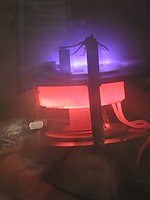
Photo from wikipedia
Abstract Previous studies have considered the same temperature for all components of the silicon etching solution, and the effect of the temperature of the individual components on the etching results… Click to show full abstract
Abstract Previous studies have considered the same temperature for all components of the silicon etching solution, and the effect of the temperature of the individual components on the etching results has not been explored. In the present study, a diamond-wire-sawn (DWS) multi-crystalline silicon wafer was etched twice for 50 s each time. The initial temperature of HF was selected to be room temperature, 55 and 66 °C, whereas those of H2O2 and Cu(NO3)2 varied between 40 and 70 °C, 40 and 72 °C, respectively. The temperature of the three components of the solution was allowed to change over time. The effects of H2O2, Cu(NO3)2, and HF temperatures on the etch morphology, reflectivity, and energy conversion efficiency of the fabricated solar cells were investigated. The saw marks of a DWS wafer were determined to be the preferred nucleation sites for the formation of the inverted pyramid (IP) structure. The optimum temperatures for etching Si to obtain a large area of IP structure were ~72 °C for Cu2+, ~25 °C for HF, and ~55 °C for H2O2. The strong isotropic etching ability of high-temperature HF caused the silicon crystal surface to deviate from the IP structure and left many recombination centers on the surface. A wafer with an IP structure on the entire surface exhibited the highest energy conversion efficiency of 18.21%. A simple wet-chemical post-processing step is expected to reduce the recombination centers and improve the energy conversion efficiency of the fabricated solar cell.
Journal Title: Solar Energy Materials and Solar Cells
Year Published: 2020
Link to full text (if available)
Share on Social Media: Sign Up to like & get
recommendations!